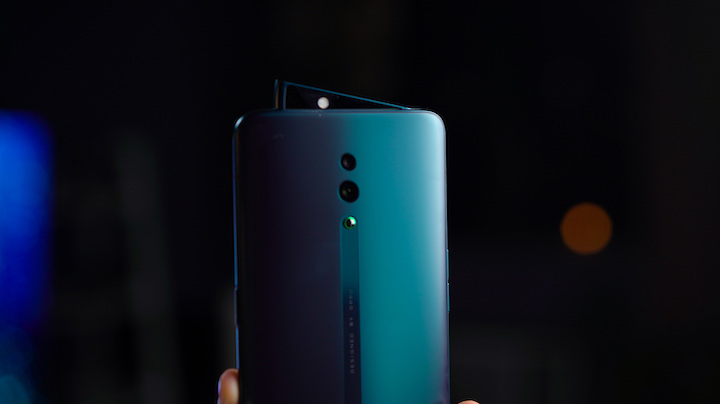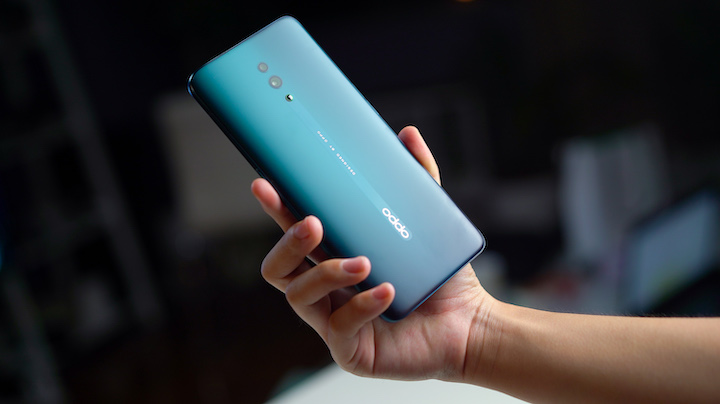It looks like the Snapdragon 660 is OUT as Qualcomm’s premier mid-range chipset, and models like the 670, 710, and 712 are on the rise, with phones like the Vivo V15 Pro, Google Pixel 3a, Realme 3 Pro, Xiaomi Mi 9 SE, and of course, the OPPO Reno.

Sporting an almost flagship-level design, the Reno is set apart from the sub-20,000 peso mid-range category in terms of looks, feel, and function. This phone’s design is largely what defines its premium mid-range status.
Table of Contents
Design and Construction

The Reno is a very slick mix of anodized aluminum and glass – Both sides are actually protected, with the front being Gorilla Glass 6, and the back being Gorilla Glass 5 with a mostly frosted finish. The Gorilla Glass 6, in particular, is great, because that’s extra protection for the in-display fingerprint scanner.

On the right, we have a green-accented power button that looks really cool. And at the bottom, headphone jack, microphone, Type-C port, and loudspeaker.

There’s a lot to love about this phone’s design, but like I said in my hands-on video, the back is my favorite part. Aside from the matte texture that doesn’t attract that many fingerprints, the camera modules are mounted flush, avoiding any scratches from tables.

And to add to that, we have the little raised portion below the cameras called the O-dot, which further raises the rear cameras from the surface they’re resting on. It, along with the thin glossy strip along the spine, add some serious appeal to the phone’s design.

Then, of course, we gotta talk about the reason the Reno caught everyone’s attention – the so-called shark-fin camera that’s a unique departure from the rectangular pop-up cameras we’ve seen from OnePlus, Vivo, and even OPPO themselves. We can’t exactly say it’s a new thing for them though, because these guys are the ones who made the Find X, after all.

The wedge-shaped design is supposedly more structurally sound, as well as easier to retract in case of a fall, which the Reno can of course detect. It looks pretty, it works, and it allows for that amazing 93% screen-to-body ratio, though I do have a minor qualm about it. Did the LED flash really have to be here? As with any type of mechanical component, the less use the motor sees, the longer it will last.

So for me, it would have been a better design choice to instead have the LED flash mounted at the back with the rear cameras. This way, the shark-fin only has to pop out only when the front camera needs to be used.

Rounding out the rest of the design, we have the volume controls and SIM tray on the left. No microSD card slot here, but for me, this is okay since the base variant has 128GB of internal storage anyway.
Display and Multimedia
Taking a look at media consumption, we get a really nice 6.4-inch AMOLED panel with a resolution of 2340 x 1080. First off, the experience is amazing. I’ve said this time and time again, but being able to watch a video with almost no bezels and absolutely no notch to distract you is awesome.

The 1080p AMOLED screen is really sharp, gets really bright, the colors are just spot on, and contrast is on point, especially when you’re watching content with darker shots. The OLED-based panel also means you have an always-on display available, which is of course really handy for quickly checking the time or if you have any notifications.

So while that’s all good and dandy, the downward firing speaker is just atrocious. While it does get loud enough to be sufficient for very casual use, don’t expect to be impressed in any way when listening to music or watching videos. You get an almost nonexistent soundstage, highs and mids are not as crisp as you’d expect them to be, and bass is nowhere to be found. Bottom-line? Yeah, you might wanna carry a pair of headphones at all times.
Camera
Moving on to the cameras, we have a dual setup at the back — namely a 48MP Sony IMX586 main sensor and a 5MP depth sensor, and for selfies, a 16MP sensor.

The cameras are impressive! With good lighting, standard shots from the rear cameras are sharp with decent dynamic range, and colors are on the more saturated side, but not overdone. You do need to head over to the settings to change the resolution to 48MP, and when you do, overall color and exposure quality doesn’t change a lot, but there’s a noticeable increase in detail, as you would expect.
Portrait shots are great, with a pleasant-looking bokeh effect, and good subject-background separation even with harsh backlighting, Argo’s fur is still nicely separated. You can also get really close to your subjects, as there’s a built-in macro mode as well.
When you move to low light, prepare to be impressed. Even with the standard auto mode with AI scene detection, you can get some pretty good shots, but turning on the dedicated Night Mode, and wow. You just get an overall cleaner image that’s better exposed, the highlights aren’t too blown out, and details in the shadows get brought up.

For selfies, as long as you have good lighting, the little details on your face are captured, skin tones are pretty much accurate, and the beauty mode isn’t overdone when you have it on. Portrait selfies are also very good, with decent subject-background separation.
For videos, you can shoot up to 4K with the rear camera — it provides a very sharp image with great colors, however, the image stabilization is lost. You have to bump down to 1080p if you want stabilization.
So the verdict for the Reno’s cameras — they’re impressive. You can get sharp images with the 48MP sensor, portrait mode is great, the night mode is amazing, and the front camera can hold its own too.
OS, UI, Apps
For software, we get ColorOS 6 on top of Android Pie, and honestly, it’s grown on me, and I started to appreciate the minimal, Apple-inspired look. Pre-installed apps are available like Facebook, Lazada, and Opera browser.

The usual features found in other ColorOS 6-powered OPPO smartphones like the F11 Pro are found here as well like smart assistant dashboard, smart sidebar, Assistive ball, 1uick gestures and motions, O Roaming, and Hyper Boost.

We also get face-unlock for an additional layer of biometric security. You don’t have to swipe up on the lock screen for it to activate, and the speed at which it unlocks the phone is dictated by how fast the front camera pops up, which again, is decently fast.
Performance and Benchmarks
Moving on to performance, the Reno’s got a Snapdragon 710 chipset with an Adreno 616 GPU, 6GB or 8GB of RAM, and 128GB or 256GB of internal storage. The unit we have here has 6GB of RAM and 256GB of storage, therefore will be the basis of our benchmarks and our overall performance evaluation.

Checking out our benchmark scores, the Reno did great. Good scores across the board, which indicates smooth performance for any sort of gaming, multitasking, or productivity. And that’s exactly what we experienced during our time with it.
• AnTuTu – 155,330
• Geekbench 4 – 1,481 (Single-Core), 5,843 (Multi-Core), 6,699 (RenderScript)
• 3D Mark SSE – 1,813 (OpenGL ES 3.1), 1,743 (Vulkan)
• PC Mark – 6,532 (Work 2.0)
• AndroBench – 475.31 MB/s (Read), 203.28 MB/s (Write)
But interesting to note that the Reno has the same hardware setup as the Realme 3 Pro, and putting their benchmark scores side-by-side, the resemblance is uncanny. And do note that the Realme 3 Pro costs significantly less. But in any case, I guess the Reno makes up for this in its other features — such as the aforementioned in-display fingerprint scanner, which is decently fast, since it’s the optical variety.
Connectivity and Battery Life
When it comes to connectivity, we have the usual stuff like dual-SIM support with 4G LTE, GPS, Bluetooth 5.0, WiFi ac, and NFC which is uncommon in mid-range devices. Calls are loud and clear, location-based apps like Waze and Google Maps work well, and mobile data is fast but that depends on your area.

For power, we get a 3,765mAh battery with VOOC 3.0 flash charge. Now, this is a little bit less than what has come to be the standard 4,000mAh, nonetheless, the Reno actually lasts a pretty long time! In our standard video loop test, we got a whopping 21 hours of playback, and this translates to day-to-day use. In my time with the device, I was easily able to get a day and a half of moderate usage.
For charging, I’m always impressed with VOOC charging, it only takes about an hour to get from 20% to 100%. It’s not SuperVOOC, but hey, this is a mid-range phone and I’ll take it.
Conclusion
Let’s list down everything you get for the money. You get an outstanding design, amazing cameras, a long-lasting battery with FAST charging, cool shark-fin camera, in-display fingerprint scanner, and some creature comforts like USB-C and Gorilla Glass on both sides. Despite having the same performance as a phone that costs more than PHP 10K less, all the extra features you get with the Reno justify its price.

The 6GB RAM + 256GB storage variant will cost PHP26,990 locally, though right now we don’t know how much the other two variants will cost. Despite the steep asking price for a mid-range device, the Reno definitely shows up strong and justifies its own price tag
OPPO Reno specs:
6.4-inch FHD+ (2340 x 1080) AMOLED display, 402ppi
Corning Gorilla Glass 6
Qualcomm Snapdragon 710 2.2GHz octa-core CPU
Adreno 616 GPU
6GB LPDDR4x 1866mhz RAM + 128GB / 256GB UFS 2.1
8GB LPDDR4x 1866mhz RAM + 256GB UFS 2.1
48MP Sony IMX586 F1.7 main + 5MP F2.4 DoF camera
16MP F2.0 front camera
Dual-SIM
4G LTE
WiFi 802.11 a/b/g/n/ac
Bluetooth 5.0
GPS, A-GPS, GLONASS, BDS, Galileo
NFC
USB Type-C
3.5mm audio jack
In-display fingerprint scanner
Face Recognition
ColorOS 6 (Android 9.0 Pie)
3,765mAh battery w/ VOOC Flash Charge 3.0
156.6 x 74.3 x 9.0 mm
185 g
What I liked:
• Beautiful design
• Good display
• Great cameras
• Good performance
• Long battery life w/ fast charging
What I didn’t:
• No microSD slot
• Weird flash placement
• Chipset could have been better for the price
With inputs and editing by Louie Diangson
Product shots by Alyza Angeles

























